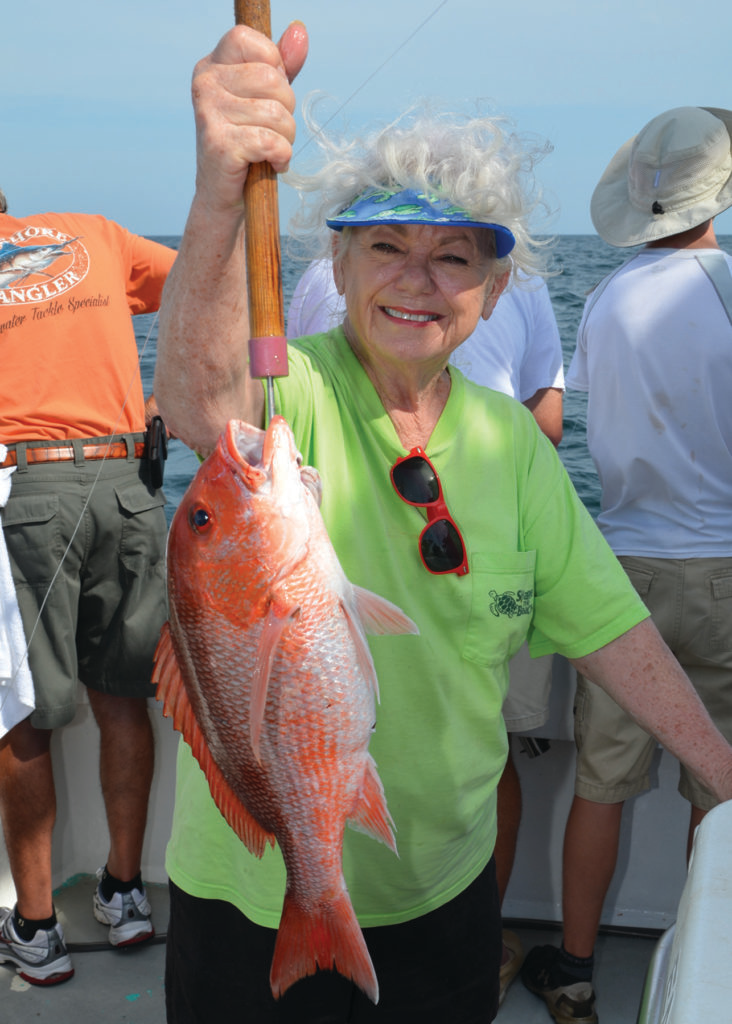By John N. Felsher
The annual recreational red snapper season begins May 22 in waters off Alabama. The season will continue every Friday through Monday until anglers meet the established federal quota of 1,122,662 pounds.
“The snapper season looks really promising this year, as it has for the past several years,” says Kurt Tillman, who runs Captain Kurt Charters out of Dauphin Island. “We don’t have any problem catching a limit of red snapper. I know hundreds of spots and we catch quality fish every time.”
Red snapper and other bottom fish congregate around hard structures like reefs, rigs and wrecks. Thanks to a very aggressive artificial reef program, Alabama offers anglers some of the best snapper fishing in the nation. The reefs stretch across more than 1,200 square miles off the Orange Beach-Gulf Shores area and near Dauphin Island. For more information on reefs and reef locations, see www.outdooralabama.com/saltwater-fishing/artificial-reefs.
“At the beginning of the season, people can catch a lot of snapper at the close rigs and reefs,” Tillman says. “People in small boats can fish some of these and catch a good limit of legal-sized snapper. One of my favorite spots to fish at the beginning of the season is the bridge rubble reef. It’s a big public spot about 14 miles south and a little to the west of Dauphin Island. It usually holds some big fish on it, especially during the first few weeks of snapper season.”
Besides red snapper, the artificial reefs and other structures form habitat for various snapper species, such as gray snapper, also known as mangrove or black snapper. Anglers might also catch vermilion snapper, commonly called beeliners, and lane snappers. In addition, anglers fishing for red snapper might hook into amberjack, triggerfish, several grouper varieties and other species. Check the season dates and limits before keeping any fish.
“I like to fish a little farther out,” Tillman says. “When people run a bit farther out than most other people, they usually catch bigger fish because fewer people fish there. The pyramid reefs about 30 miles from Dauphin Island can produce a lot of good fish.”

Photo by John N. Felsher
Reefs also create hunting grounds for roving predators like sharks, cobia, king mackerel and barracuda that feed upon reef dwellers. While bottom bouncing for snapper, anglers might want to set a drift line baited with a live fish or other tempting morsel. Toss the bait on an unweighted line behind the boat. Stick the rod into a holder and wait for a passing predator to grab the bait. A struggling live fish might even call a giant snapper up from the depths. In deep enough water, a drift line could attract wahoo, blackfin or yellowfin tuna, possibly sailfish.
“Frequently, the bigger snapper come up near the surface,” Tillman says. “Sometimes, we chum fish up to the surface and catch them on a drift line. When we chum up fish, they get in a feeding frenzy. It’s always fun when people can see the fish they’re trying to catch.”
Over a good spot off the Alabama coast, anglers seldom need to fish very long to land a limit of red snapper. After catching their snapper, many anglers look for other fishing opportunities. Offshore anglers can troll an assortment of spoons, deep-running plugs, jigs or natural baits to entice king mackerel, cobia, wahoo, dolphin, also called mahi or dorado, tuna and other species. Some anglers maximize their time offshore by trolling when transitioning from one spot to another. Trolling can also reveal a new secret honey hole.
“There’s a lot of other fish to catch off Alabama besides red snapper,” Tillman says. “In 2019, we caught a tremendous amount of cobia. We often see cobia coming up to the boat when snapper fishing. It’s always a good idea to keep a line ready to cast a bait.”
While moving from place to place, watch for targets of opportunity. Cobia, mahi and tripletail regularly hide under floating debris, weeds, channel buoys and other flotsam, sometimes as small as a drink can. Anglers might see something that they can add to their fish boxes. After spotting a fish, approach quietly. Whenever possible, let the wind or currents push the boat toward the object to avoid spooking the fish.
During the season, every recreational angler can keep up to two red snapper per day with a minimum size of 16 inches in total length. Anglers must report their red snapper catches through Snapper Check. For more on Snapper Check, see outdooralabama.com/mrd-fisheries-section/red-snapper-faqs.




